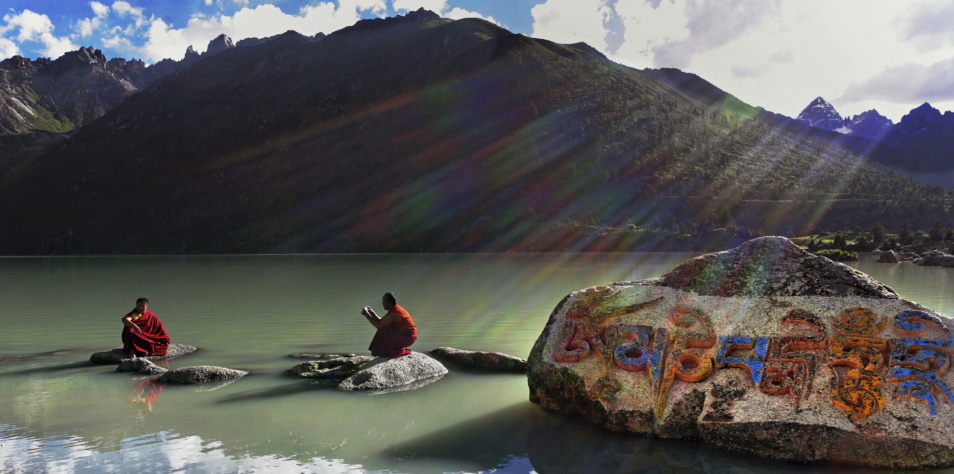#11 – July 2015 Newsletter
In this edition:
Trulshik Rinpoche’s Reincarnation is Recognized
Three Year Retreat Concludes Successfully Despite the Earthquake
The April 25th Earthquake: A Personal Account
Support Shechen!
Tsering Art School Exhibition in Hong Kong
Thanks to Volunteers and Donors
New English Translation of Matthieu Ricard’s Book, “Altruism”
Other Links
Joyous Occasion: the Tulku of Trulshik Rinpoche
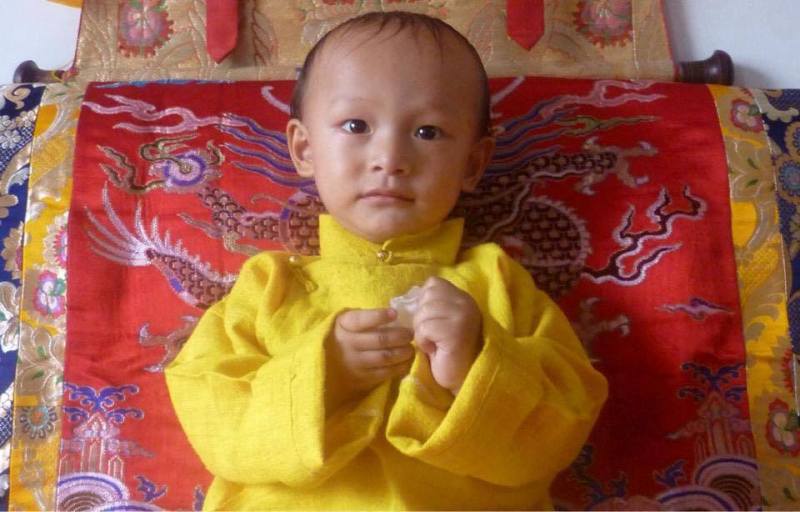 Minling Dungse Rinpoche has recognized the reincarnation (tulku) of Kyabje Trulshik Rinpoche. As requested by Solpon Ngawang Tsephel and other lamas, His Holiness the Dalai Lama gave his supporting letter acknowledging the tulku. On July 22, he performed the traditional hair cutting ceremony.
Minling Dungse Rinpoche has recognized the reincarnation (tulku) of Kyabje Trulshik Rinpoche. As requested by Solpon Ngawang Tsephel and other lamas, His Holiness the Dalai Lama gave his supporting letter acknowledging the tulku. On July 22, he performed the traditional hair cutting ceremony.
Trulshik Rinpoche was a close friend and student of the previous Dilgo Khyentse Rinpoche, a principle teacher of HH Dalai Lama, Rabjam Rinpoche, and many other teachers. He was renowned for his kindness, wisdom, and scholarship and was beloved by all of us at Shechen and by thousands of people in Nepal and around the world.
We wish the young reincarnation a very long life and successful fulfillment of all his activities.
Three-Year Retreat Concludes Successfully Despite the Earthquake
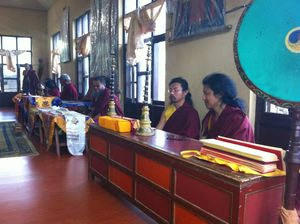 In the midst of the destruction and tragedy that the April 25th earthquake brought to many parts of Nepal, there are also many heart-warming stories of courage and compassion, and many lives have been saved. Our monks were among those who worked so tirelessly.
In the midst of the destruction and tragedy that the April 25th earthquake brought to many parts of Nepal, there are also many heart-warming stories of courage and compassion, and many lives have been saved. Our monks were among those who worked so tirelessly.
We also had cause to rejoice as the fourth Shechen three-year retreat concluded as scheduled. (The retreat began March 11th 2012 and finished on 1st May 2015.) The retreat center, Drupde Pema Odseling, is located a few miles from one of the oldest known pilgrimage places in the world, Namo Buddha. It is located in a beautiful setting in Kavre district, about 40kms from the heart of Kathmandu, to the south-east of the valley.
There were seven monks in the retreat, some of whom are graduates from Shechen’s Shedra (Philosophical College.) The resident Retreat Master is Lama Gyurme Sangye, who has completed 6 years of retreat. All the practices followed were from the treasure teachings (terma) discovered by Dilgo Khyentse Rinpoche. Khyentse Yangsi Rinpoche, Shechen Rabjam Rinpoche, and other teachers gave extensive teachings on these practices before and during the retreat.
The 7.8 magnitude earthquake struck just days before the retreat was scheduled to conclude and tremors were strongly felt in Namo Buddha. Despite this, the monks were able to continue their concluding practices and pujas on time by practicing together in their yoga house as the aftershocks passed. The concluding ceremony to open the boundary was presided over by Lama Gyalwo and Lama Gyurme Sangye.
Shechen’s retreat buildings do not appear to have sustained serious damage. However, the neighboring compound for seniors was destroyed and will have to be rebuilt. Luckily, no one sustained any injuries.
A new group of monks have already settled in for the fifth three-year retreat. From the many monks who applied to join this retreat, only seven were chosen due to space limitations. We wish them a fruitful and productive retreat!
The April 25th Earthquake: A Personal Account
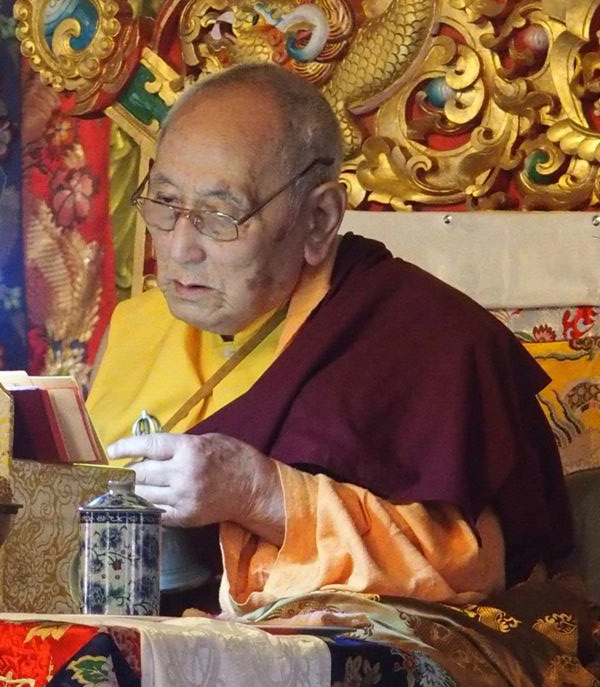 We have been regularly posting information about Shechen’s relief work and the damages incurred after the earthquake. But what exactly happened in the monastery on that day? Here is a firsthand report:
We have been regularly posting information about Shechen’s relief work and the damages incurred after the earthquake. But what exactly happened in the monastery on that day? Here is a firsthand report:
On April 14, Yangthang Rinpoche began a series of ten days of empowerments in the temple. Yangthang Rinpoche is one of the greatest living masters and lineage holders of the Nyingma tradition. He is 86 years old and, with undaunted energy and kindness, he gave the empowerments for the termas of Ratna Lingpa, and also an empowerment from the treasure cycle of his predecessor. He sat in the temple continuously every day, often for 10 hours at a time. Receiving these empowerments from him was alone was an amazing experience. His attention to detail, precision, and humor are unique and powerful.
A large tent was setup above the courtyard for the crowds of people who could not fit into the temple so they could participate and watch the large screens showing the events inside. Throughout the previous drupchens (9-day ceremonies) and the empowerments, I kept remarking to myself how strikingly beautiful the large Shechen temple is with its exquisite and lively frescoes designed by Dilgo Khyentse Rinpoche, depicting in careful and lovely detail, the teachers and deities of the schools of Tibetan Buddhism. There is even a small mural showing how monks should take care of their vows. I wondered anew at the beauty and majesty of the statues, the sacredness of the monastery that Khyentse Rinpoche built to transplant the Shechen tradition in exile from Tibet, where so many great teachers taught and were taught. This sacred space provided a sense of beauty, security, and peace.
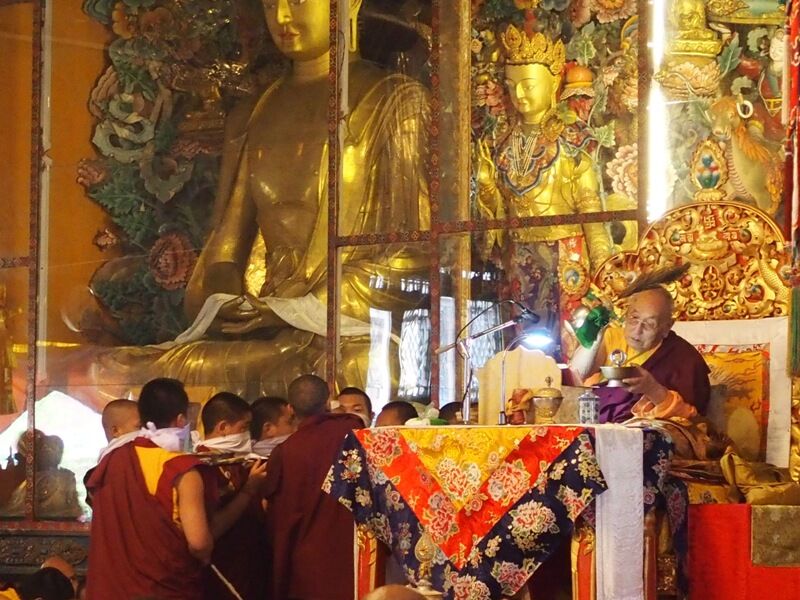 The empowerments ended on Friday, and on Saturday a concluding long life empowerment was to be performed. Important long life empowerments are often occasions for the Nepalese, Buddhist and non-Buddhist, to gather with their families as an outing for the day at the monastery. Starting early in the morning, lay people – young and old – and monastics, started streaming into the compound.
The empowerments ended on Friday, and on Saturday a concluding long life empowerment was to be performed. Important long life empowerments are often occasions for the Nepalese, Buddhist and non-Buddhist, to gather with their families as an outing for the day at the monastery. Starting early in the morning, lay people – young and old – and monastics, started streaming into the compound.
The empowerment began around 11:50 AM. Yangthang Rinpoche was sitting high up on the brocade throne in front of the large statues of the Buddhas of the Three Times that are protected by huge panes of glass.
Gathered around the throne were the tulkus who had attended the empowerments and some who had just come for that day, including Dilgo Khyentse Yangsi, Bhutanese Dudjom Yangsi, Tulku Urgyen Yangsi, other tulkus and khenpos from Shechen, Mysore, and other monasteries in India, Tsikey Chokling Rinpoche, and Phakchok Rinpoche and his wife. In the front rows were khenpos, tulkus, and monks and nuns, and about 2000 lay people crowded into the remaining space. Outside in the courtyard about 3000 lay people and monks were seated to receive the empowerments.
As part of the ceremony, soon after the empowerment began, a small fire was lit for a fire ceremony. Yangthang Rinpoche’s beautiful, soft, and lyrical voice was resounding.
At that moment, I heard the most terrible sound…a cracking and thundering mixed with the cries of surprise from the people outside who saw the building swaying before we even felt it. The temple started tilting side to side, the chandeliers swinging in circles high above our heads, I could feel the column I was sitting against moving side to side…a swaying ship. The most feared event in Nepal: an earthquake. I watched with trepidation the large panes of glass behind Yangthang Tulku.
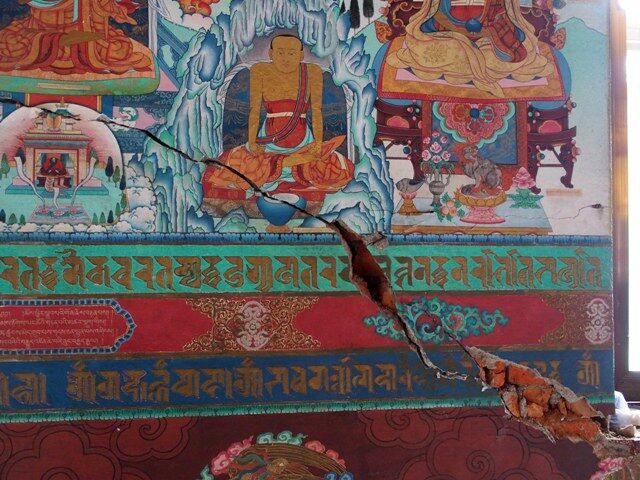 Everything seemed in slow motion within the violent shaking movement of the building. I heard only the sound of the cracking and the flowing, melodious voice of Yangthang Rinpoche, who never paused and began chanting the Dusum Sangye, Tara, and Barched Lamsel prayers. His voice floated on with ease throughout the entire earthquake and the strong immediate aftershocks never stopping.
Everything seemed in slow motion within the violent shaking movement of the building. I heard only the sound of the cracking and the flowing, melodious voice of Yangthang Rinpoche, who never paused and began chanting the Dusum Sangye, Tara, and Barched Lamsel prayers. His voice floated on with ease throughout the entire earthquake and the strong immediate aftershocks never stopping.
I looked around and saw Chokling Rinpoche embracing his two sons. My eyes turned again to Yangthang Rinpoche and never left him. He just continued doing the mudras and gestures, and reading the text, his bell and drum resounding, not moving, never-changing, the beautiful Buddhas behind the glass looking down at him.
Large cracks started to form in our precious frescoes. The wall with the images from the Kagyu lineage that was on my right began to cave in. Yangthang Rinpoche was unmoving, continuing. The strange juxtaposition of the whole world moving and the unchanging presence of the guru was amazing, and actually what the teachings on the guru are all about.
When this long quake ended, a monk shouted, “Now everyone leave”. I walked out of the temple calmly, put on my shoes. No one was pushing or rushing at that point. Yangthang Rinpoche’s attendant told him that he needed to leave. He asked why. He was content to finish the empowerment there, but then when they told him that Yangsi Rinpoche would not leave without him, he decided to go.
He entered the large tent and sat in a chair that was quickly provided for him in the middle of the crowd, in the middle of the tent. [click this link to view video] For the next 20 or so minutes he proceeded to finish the empowerment, the lamas around him, receiving the blessings, even throughout the second frightening tremor that caused further damage. The crowd was perfectly calmed by his presence, and sat quietly to receive the empowerment. The little monks served tea to the assembly. The trained monks started to work on protecting and helping the crowd.
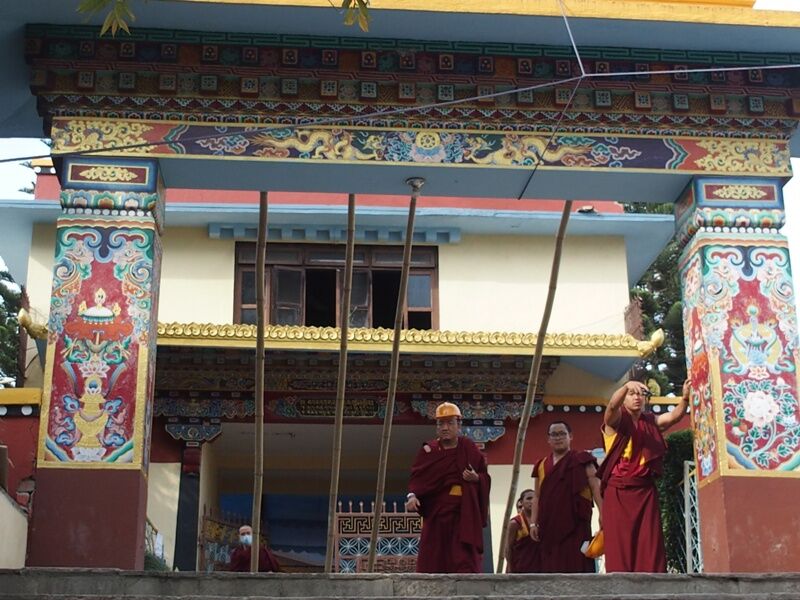 For the next days, weeks, and, in some cases, months, everyone slept outside in tents and under tarps, including Yangthang Rinpoche and Khyentse Yangsi Rinpoche. Their residences at the monastery had been destroyed.
For the next days, weeks, and, in some cases, months, everyone slept outside in tents and under tarps, including Yangthang Rinpoche and Khyentse Yangsi Rinpoche. Their residences at the monastery had been destroyed.
Our monastery and the whole of Nepal were changed, but the core of devotion, resilience, and compassion remains. The history of Shechen built with so much care, difficulty, and love will always be part of us. Soon major restoration will begin to restore the monastery and we will continue forward with a new beginning.
Vivian Kurz
Director Dilgo Khyentse Fellowship
Support Shechen’s Post-Earthquake Activities
We deeply appreciate the donations that we have received to support the restoration work needed for the Nepal Monastery. Funds are also still needed to resume full activities after the earthquake, for sponsorship of nuns and monks, and for our monasteries, schools, and nunnery in India and Bhutan.
Many of our donors find monthly donations a wonderful way to support Shechen’s activities, while making it feasible to work into their own budgets. You can sign up for monthly donations at www.shechen.org/donate. Please check the box “make this recurring” on the donation link.
You can also make one-time donations via PayPal, by check or wire transfer, and through a stock transfer.
If you would like to help by organizing fundraising events, please do not hesitate to email us.
Thank you for your support!
Tsering Art School Exhibition in Hong Kong
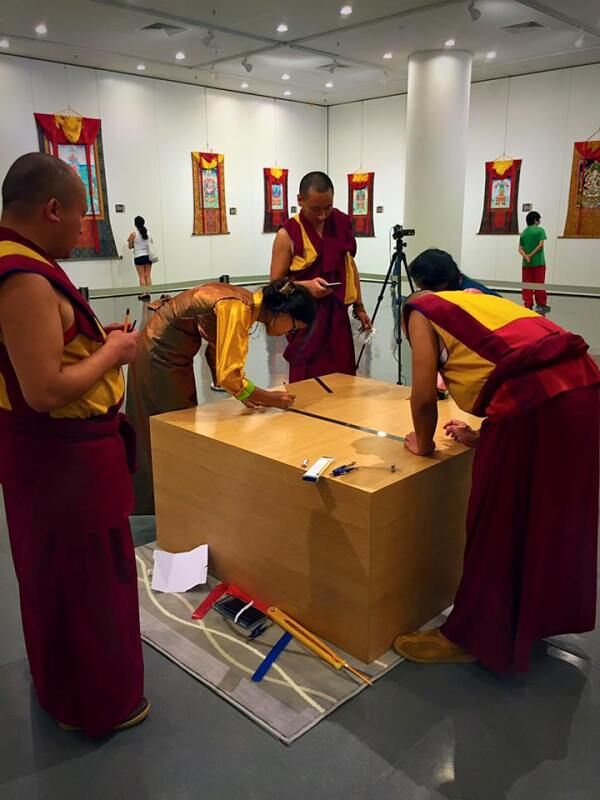 A very successful exhibition of the work of graduate artists from Shechen’s Tsering Art School in Nepal was recently held in Hong Kong. The show was organized by the local Shangpa Kagyu Center and was held from 3-12th July at the Central Library in Causeway Bay.
A very successful exhibition of the work of graduate artists from Shechen’s Tsering Art School in Nepal was recently held in Hong Kong. The show was organized by the local Shangpa Kagyu Center and was held from 3-12th July at the Central Library in Causeway Bay.
Six senior artists and teachers, consisting of both lay-people and ordained monks, traveled from Nepal to participate in the show. Over fifteen thangkas were on display in the large hall. The artists also created a Vajrasattva sand mandala and conducted drawing and painting demonstrations, which were very well attended and received. Konchog Lhadrepa, the master painter and Principal of the school, gave a series of talks on the art of thangka painting and the meaning of the sacred mandalas.
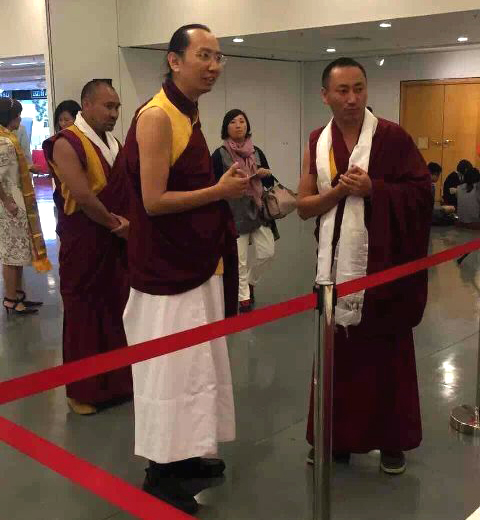 The exhibition was also visited by His Eminence Ratna Vajra Rinpoche who conducted the concluding blessing ritual of the sand mandala and praised the exceptional quality and standard of the artworks.
The exhibition was also visited by His Eminence Ratna Vajra Rinpoche who conducted the concluding blessing ritual of the sand mandala and praised the exceptional quality and standard of the artworks.
More than 5,000 people visited the exhibition. The exhibition has generated further interest and admiration for the Buddhist art tradition being practiced and taught at the Tsering Art School and by the artists of the Rabsel Thangka Studio.
Thanks to Volunteers and Donors
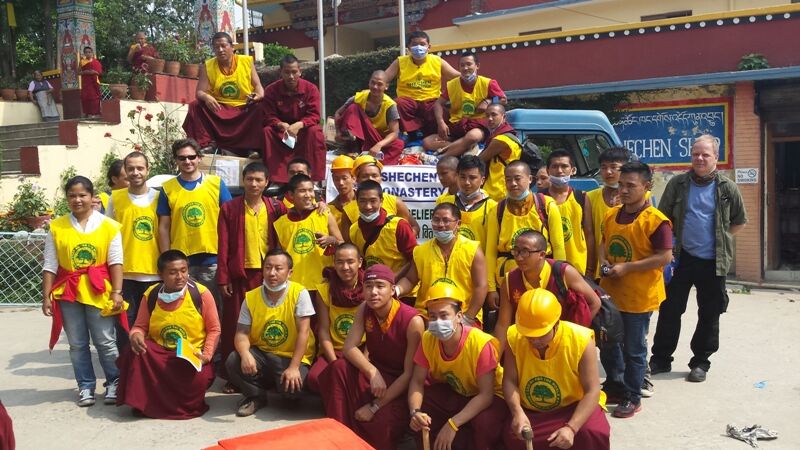 Monastery life involves training and discipline and the disaster readiness training our monks received from workshops and foreign volunteers and friends of the monastery proved to be a means of saving lives and delivering aid to so many. We cannot express enough how proud we are of our monks, tulkus and khenpos who have been working tirelessly, in difficult and dangerous circumstances, for the most affected people of Nepal since this disaster.
Monastery life involves training and discipline and the disaster readiness training our monks received from workshops and foreign volunteers and friends of the monastery proved to be a means of saving lives and delivering aid to so many. We cannot express enough how proud we are of our monks, tulkus and khenpos who have been working tirelessly, in difficult and dangerous circumstances, for the most affected people of Nepal since this disaster.
In addition, we would like to take this opportunity to acknowledge and thank some of the monastery’s foreign long-term volunteers and staff for their efforts, which have been pivotal in ensuring that the monks were so well prepared. In particular Lucy Needham from America and Charlotte Davis from Australia played key roles in initiating the earthquake preparedness and Shechen Eco Group activity from within the monastery.
Long-term friend and engineer Luc Cholley from France has spent the last couple of months in Nepal closely assessing the damage and advising the monastery on its rebuilding efforts, which has been invaluable. Chris Wilvert from Canada, offered training for our monks (young and old) in earthquake readiness and fire safety, also returning after the earthquake and assisting in relief.
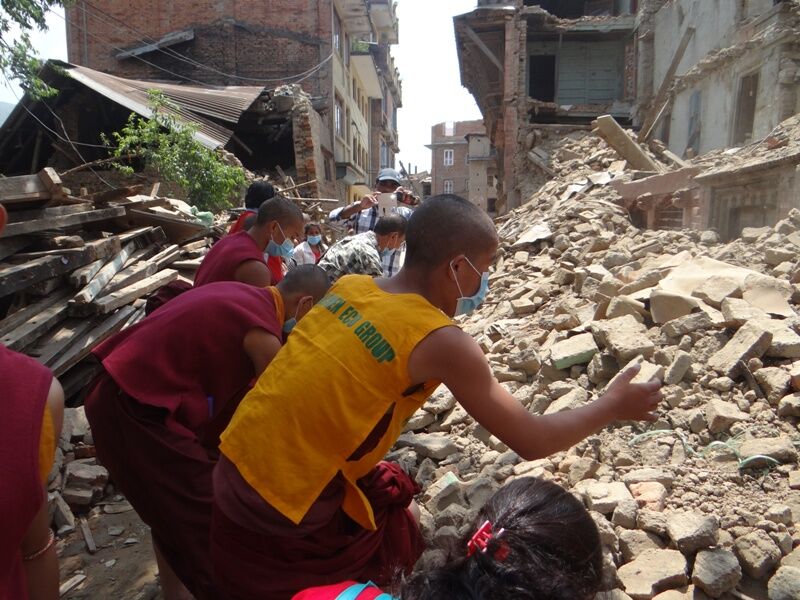 Karuna-Shechen organized the Emergency Training two years ago that was so useful during this disaster and have offered immense ongoing practical and financial support in our earthquake relief work.
Karuna-Shechen organized the Emergency Training two years ago that was so useful during this disaster and have offered immense ongoing practical and financial support in our earthquake relief work.
The monastery would like to thank Vivian Kurz, Director of Dilgo Khyentse Fellowship, for her decades of service to Shechen. Thank you also to Maricruz Carrasco for her excellent social media work, and to Sonia Gomes and Juanita Evans for their assistance, to Marina Lama in the Shechen Nepal office, and to the many other volunteers, both local and foreign, who came forward to help in the aftermath of the earthquake.
Especially, and most importantly, our deepest gratitude goes out to all our donors, from over twenty-five countries around the world, who have so generously supported our efforts over these past months. We can’t thank you enough.
New English Translation of Matthieu Ricard’s Book, Altruism
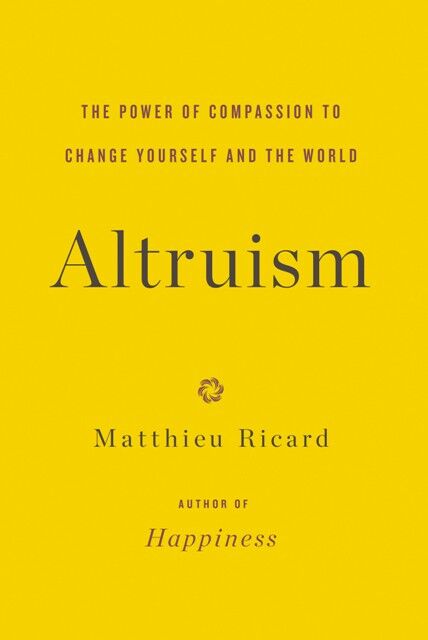 Matthieu Ricard’s bestselling book, “Altruism: The Power of Compassion to Change Yourself and the World”, is now available in English. It has been acclaimed as a masterwork a comprehensive study of altruism, and “a careful, detailed, hard-nosed assessment of what is needed both for individual happiness and for the welfare of the planet.”
Matthieu Ricard’s bestselling book, “Altruism: The Power of Compassion to Change Yourself and the World”, is now available in English. It has been acclaimed as a masterwork a comprehensive study of altruism, and “a careful, detailed, hard-nosed assessment of what is needed both for individual happiness and for the welfare of the planet.”
The book is available on-line and through booksellers. For further information: www.altruismbook.com
“Now is the time for altruism. We are facing a new challenge that we were never confronted with before in the history of humanity. For the first time ever, our activities now have a major impact on the fate of future generations.” Matthieu Ricard
Other Links
For continuing news please regularly visit our website where you can sponsor a monk or nun, donate to one of our projects, request prayers and find new information and photos. Current photos and news can also be found on our Facebook page.
